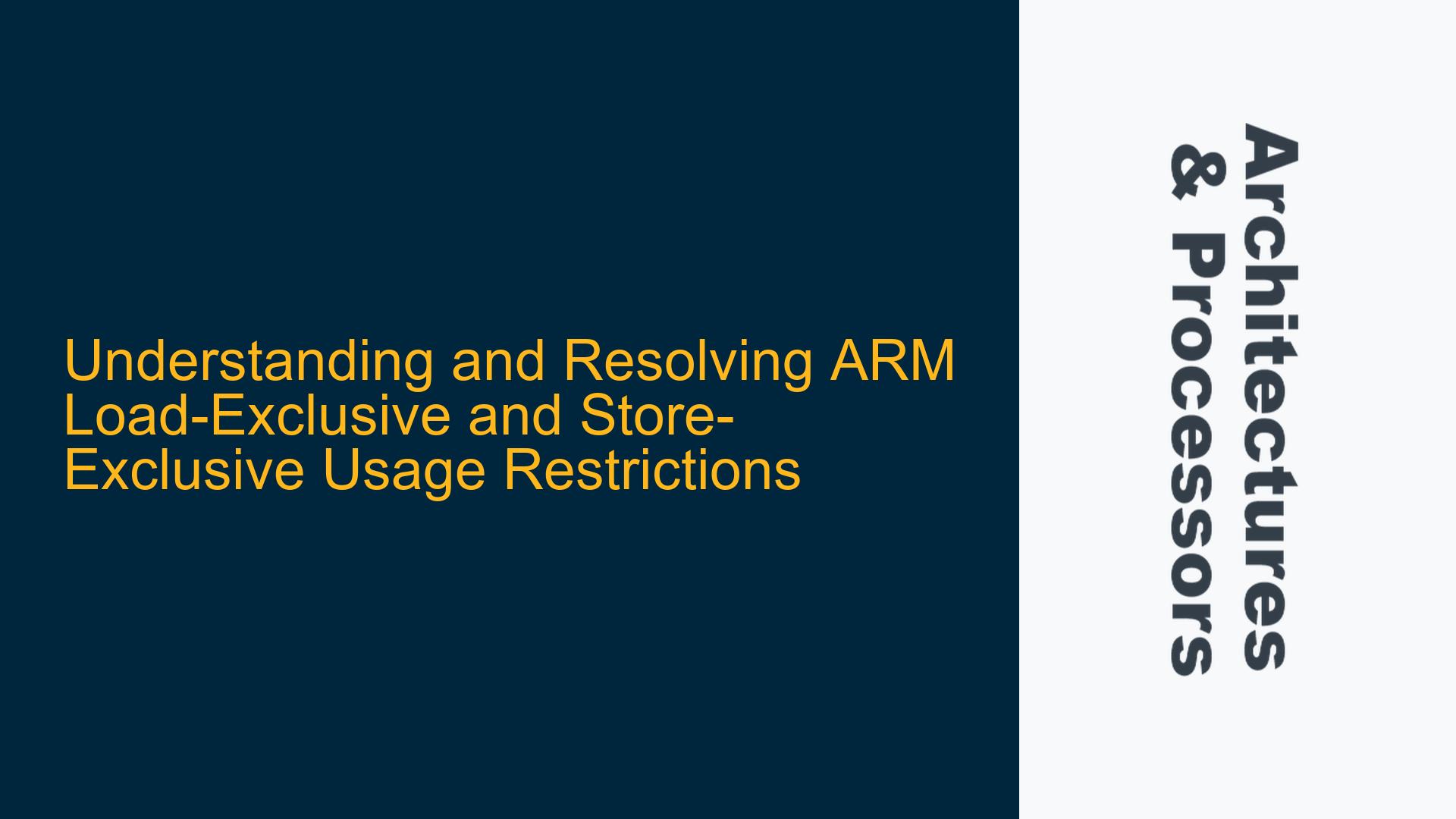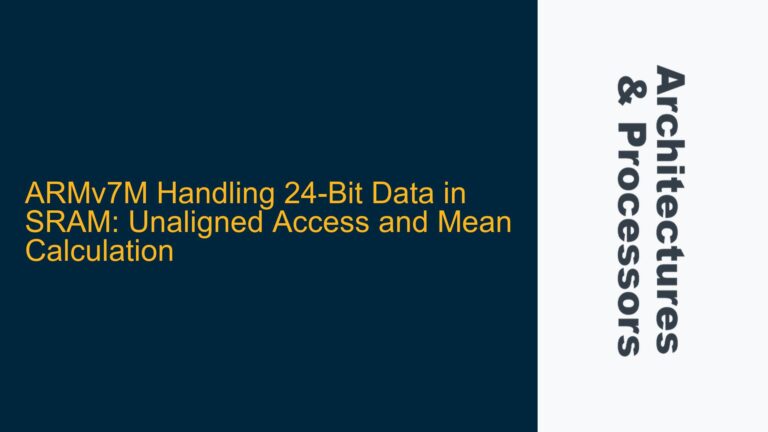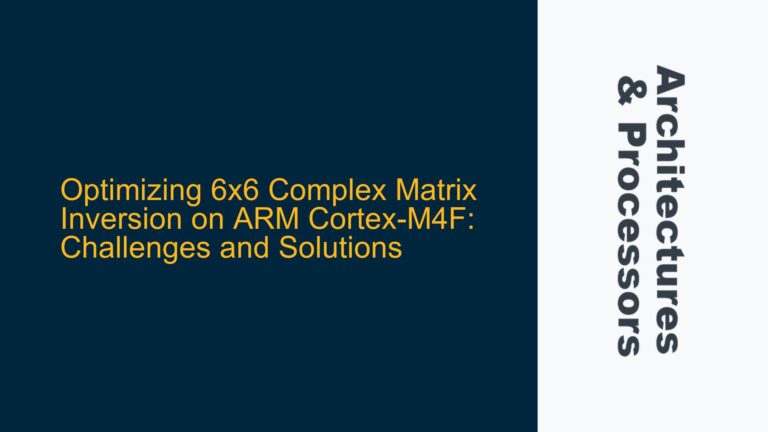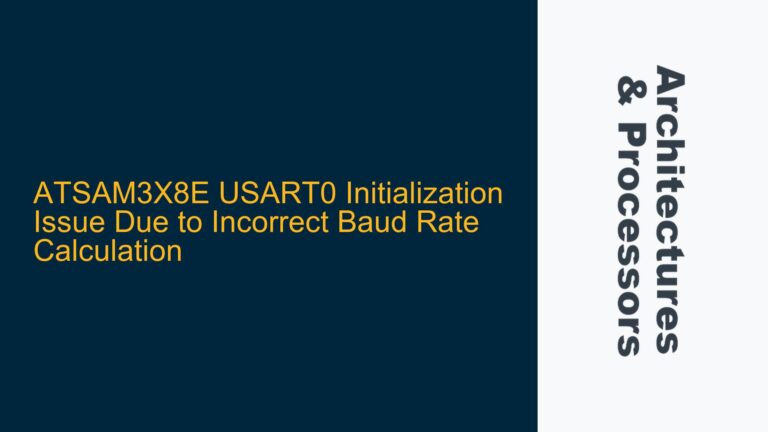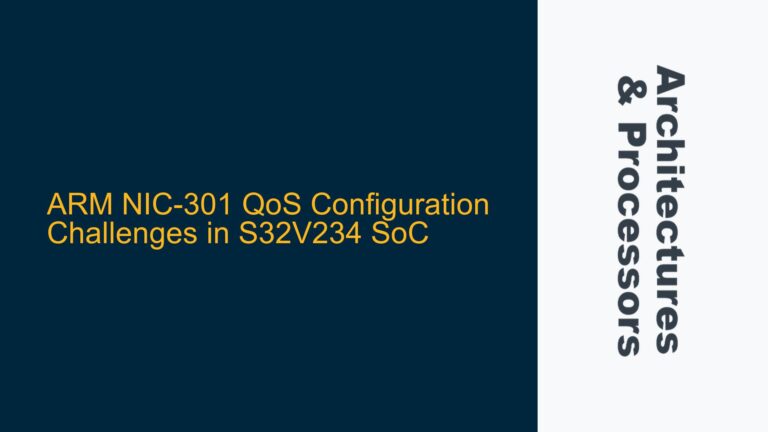ARM Cortex-M4 Cache Coherency Problems During DMA Transfers
The ARM architecture provides a set of synchronization primitives known as Load-Exclusive (LDREX) and Store-Exclusive (STREX) instructions. These instructions are crucial for implementing atomic operations in multi-threaded environments or when dealing with shared resources. However, the ARM Architecture Reference Manual for ARMv7-A and ARMv7-R explicitly states that if the target virtual address of an STREX instruction differs from the virtual address of the preceding LDREX instruction within the same thread of execution, the behavior can be UNPREDICTABLE. This unpredictability can lead to subtle and hard-to-debug issues in embedded systems, particularly when dealing with shared memory regions, DMA transfers, or multi-core processors.
The core issue revolves around the proper usage of LDREX and STREX instructions. When these instructions are not used correctly, the system may exhibit erratic behavior, such as data corruption, race conditions, or even system crashes. The unpredictability arises because the exclusive monitor, which is responsible for tracking the state of the LDREX and STREX operations, may lose synchronization if the addresses do not match. This can happen even in single-threaded environments if the programmer inadvertently changes the target address between the LDREX and STREX operations.
Memory Barrier Omission and Cache Invalidation Timing
One of the primary causes of the unpredictability in LDREX and STREX usage is the omission of memory barriers or improper cache invalidation timing. Memory barriers are essential for ensuring that the order of memory operations is preserved, especially in systems with multiple cores or DMA controllers. Without proper memory barriers, the exclusive monitor may not correctly track the state of the LDREX and STREX operations, leading to unpredictable behavior.
Another potential cause is the timing of cache invalidation. In systems with caches, the exclusive monitor relies on the cache coherency mechanism to ensure that the LDREX and STREX operations are performed atomically. If the cache is not properly invalidated before the LDREX operation, the exclusive monitor may not correctly detect changes to the memory location, leading to incorrect behavior. This is particularly problematic in systems with DMA controllers, where the DMA may modify the memory location without the knowledge of the CPU.
Additionally, the use of different virtual addresses for LDREX and STREX operations can cause the exclusive monitor to lose synchronization. This can happen if the programmer inadvertently changes the target address between the LDREX and STREX operations, or if the memory mapping changes due to context switching or memory management operations. In such cases, the exclusive monitor may not correctly track the state of the operations, leading to unpredictable behavior.
Implementing Data Synchronization Barriers and Cache Management
To resolve the issues related to LDREX and STREX usage, it is essential to implement proper data synchronization barriers and cache management techniques. Data synchronization barriers ensure that the order of memory operations is preserved, preventing the exclusive monitor from losing synchronization. The ARM architecture provides several types of memory barriers, including Data Memory Barrier (DMB), Data Synchronization Barrier (DSB), and Instruction Synchronization Barrier (ISB). These barriers should be used appropriately to ensure that the LDREX and STREX operations are performed atomically.
Cache management is also crucial for ensuring the correct operation of LDREX and STREX instructions. Before performing an LDREX operation, the cache should be invalidated to ensure that the exclusive monitor correctly detects changes to the memory location. This can be done using the cache invalidation instructions provided by the ARM architecture, such as the Invalidate Data Cache (INVD) instruction. Additionally, the cache should be flushed after the STREX operation to ensure that the changes are propagated to main memory.
To avoid the issue of different virtual addresses for LDREX and STREX operations, programmers should ensure that the target address remains consistent between the LDREX and STREX operations. This can be achieved by carefully managing the memory mapping and avoiding context switches or memory management operations that may change the virtual address. In multi-threaded environments, proper synchronization mechanisms, such as mutexes or semaphores, should be used to ensure that the target address is not modified by other threads.
In summary, the unpredictability in LDREX and STREX usage can be resolved by implementing proper data synchronization barriers, cache management techniques, and ensuring that the target address remains consistent between the LDREX and STREX operations. By following these best practices, programmers can avoid the subtle and hard-to-debug issues that arise from improper usage of these instructions.
Detailed Analysis of LDREX and STREX Instructions
The LDREX and STREX instructions are part of the ARM architecture’s synchronization primitives, designed to facilitate atomic operations in multi-threaded environments or when dealing with shared resources. The LDREX instruction loads a value from memory and marks the memory location as exclusive, while the STREX instruction stores a value to memory only if the memory location is still marked as exclusive. This mechanism allows for the implementation of atomic read-modify-write operations, which are essential for ensuring data consistency in concurrent systems.
However, the exclusive monitor, which tracks the state of the LDREX and STREX operations, is sensitive to changes in the target memory location. If the target virtual address of the STREX instruction differs from the virtual address of the preceding LDREX instruction within the same thread of execution, the exclusive monitor may lose synchronization, leading to unpredictable behavior. This can happen even in single-threaded environments if the programmer inadvertently changes the target address between the LDREX and STREX operations.
Impact of Virtual Address Changes on Exclusive Monitor
The exclusive monitor relies on the virtual address to track the state of the LDREX and STREX operations. When the LDREX instruction is executed, the exclusive monitor marks the memory location as exclusive and associates it with the virtual address. If the STREX instruction is executed with a different virtual address, the exclusive monitor may not correctly detect that the memory location is still marked as exclusive, leading to unpredictable behavior.
This issue can be particularly problematic in systems with complex memory management, where the virtual address may change due to context switching or memory mapping operations. For example, if a context switch occurs between the LDREX and STREX operations, the virtual address of the target memory location may change, causing the exclusive monitor to lose synchronization. Similarly, if the memory mapping is modified between the LDREX and STREX operations, the virtual address may no longer correspond to the same physical memory location, leading to incorrect behavior.
Best Practices for Using LDREX and STREX Instructions
To avoid the issues related to LDREX and STREX usage, programmers should follow several best practices. First, they should ensure that the target virtual address remains consistent between the LDREX and STREX operations. This can be achieved by carefully managing the memory mapping and avoiding context switches or memory management operations that may change the virtual address.
Second, programmers should use memory barriers to ensure that the order of memory operations is preserved. The ARM architecture provides several types of memory barriers, including Data Memory Barrier (DMB), Data Synchronization Barrier (DSB), and Instruction Synchronization Barrier (ISB). These barriers should be used appropriately to ensure that the LDREX and STREX operations are performed atomically.
Third, programmers should ensure that the cache is properly managed before and after the LDREX and STREX operations. Before performing an LDREX operation, the cache should be invalidated to ensure that the exclusive monitor correctly detects changes to the memory location. After performing an STREX operation, the cache should be flushed to ensure that the changes are propagated to main memory.
Finally, in multi-threaded environments, proper synchronization mechanisms, such as mutexes or semaphores, should be used to ensure that the target address is not modified by other threads. By following these best practices, programmers can avoid the subtle and hard-to-debug issues that arise from improper usage of LDREX and STREX instructions.
Conclusion
The LDREX and STREX instructions are powerful tools for implementing atomic operations in ARM-based systems. However, their correct usage requires careful attention to detail, particularly when dealing with virtual address changes, memory barriers, and cache management. By following the best practices outlined in this guide, programmers can ensure that their systems operate reliably and avoid the unpredictable behavior that can arise from improper usage of these instructions.
